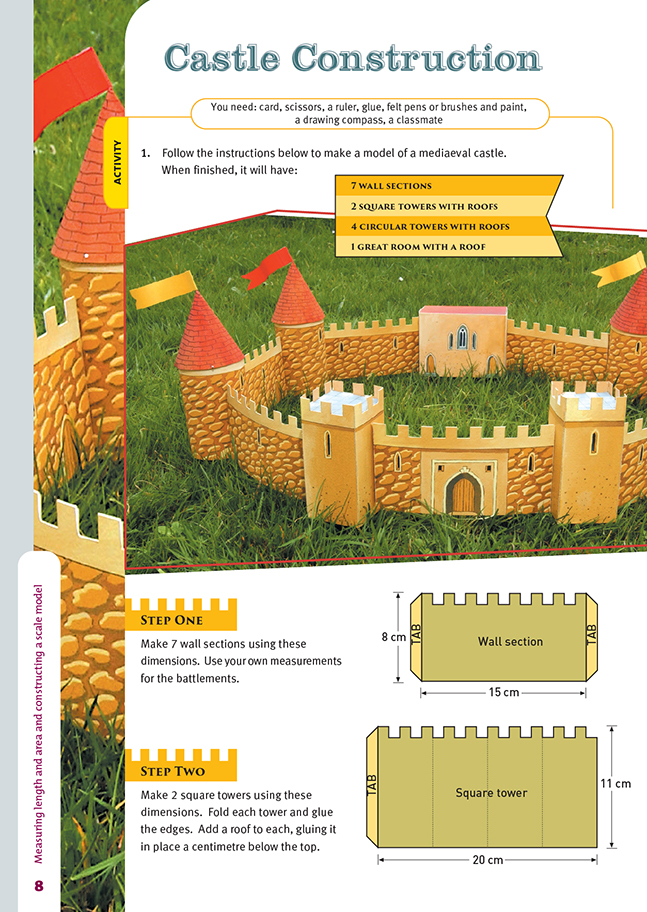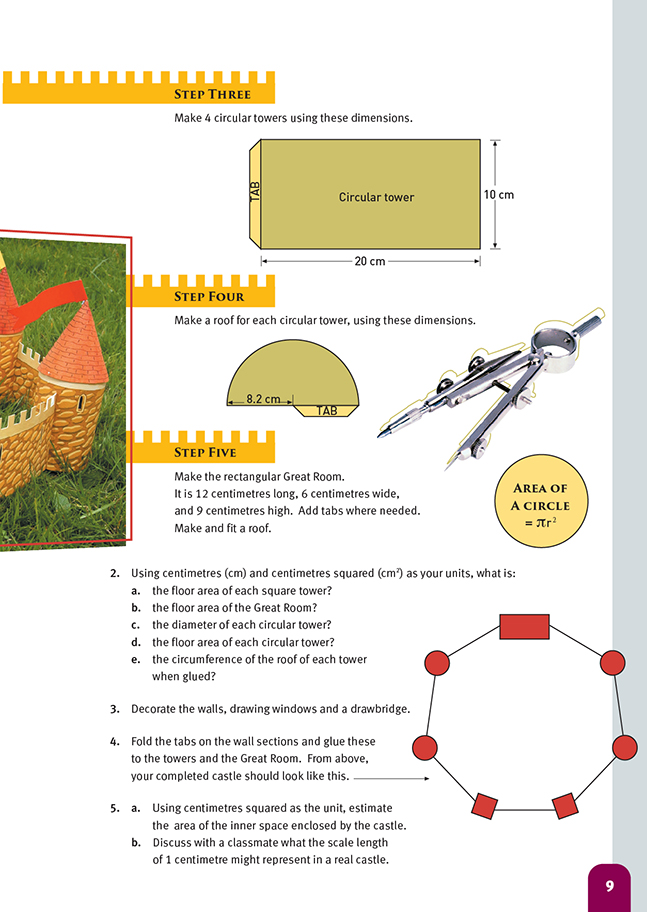This is a level 4 measurement strand activity from the Figure It Out series.
A PDF of the student activity is included.
Click on the image to enlarge it. Click again to close. Download PDF (271 KB)
measure length and area to construct a model
FIO, Level 4, Measurement, Book One, Castle Construction, pages 8-9
card, scissors, a ruler, glue, felt pens or paint and brushes
a drawing compass
classmate
The students are given diagrams (not templates) of the various parts of a model castle and then have to make the castle using card. After the model has been made, the students work out the areas of the various shapes.
From an organisational point of view, the task is a complex one (you need to ensure that there are enough materials and equipment to go around), particularly if the whole class is working on the activity at the same time.
The students could create a table for their measurements and calculations:
Finding the area of a circle is listed in level 5 of the curriculum, and if the students have not done this before, the formula (included on the page in the student book) needs to be carefully introduced at this point. As an alternative, or as an introduction to the formula, you may wish to have the students estimate the area by drawing the circle on squared paper and counting the squares.
To estimate the area of the castle’s inner space (question 5a), have the students place the completed castle on paper drawn up with a grid of 1 centimetre squares and trace around its outline. They then count the number of full squares within the outline and add to this their estimate of the number of full squares that could be made from the part squares. This is the estimated area in centimetres squared.
In question 5b, the students are asked to suggest what size the scale length of 1 centimetre might represent. Some may have difficulty with this because they cannot visualise everyday places and spaces in terms of metres. A useful starting point would be to investigate the plausibility of a scale of 1 centimetre to 1 metre. This would make the wall 8 metres high. Relate this to the height of a standard New Zealand ceiling (about 2.5 metres) and they will see that the wall would be about three times this – enough height for a very impressive wall! They could also measure out the dimensions of the Great Room on the school courts, using this scale, and try others if they wish.
Cross-curricular links
Social Studies
This activity could be part of a unit on the Middle Ages, looking at the design of medieval castles, the technology used to build them, and the social life of the day. Comparisons could be made with Māori pā. (A model of a pā could also be constructed.)
Achievement Objectives
Demonstrate knowledge and understandings of:
- the impact of the spread of new technology and ideas on culture and heritage (Culture and Heritage, level 4)
- how places reflect past interactions of people with the environment (Place and Environment, level 4)
Answers to Activity
1. Practical activity
2. a. 25 cm2. (5 x 5 cm2 )
b. 72 cm2. (12 x 6 cm2 )
c. 6.37 cm. (circumference = π x diameter
20 = 3.14 x diameter
diameter = 20 ÷ 3.14
= 6.37 cm)
d. 31.8 cm2. (area = πr2
= π x 3.185 x 3.185
= 31.8 cm2 )
e. 28.3 cm. ( π x diameter = x 3.14 x 16.4
= 25.7 cm)
3. Practical activity
4. Practical activity
5. a. Practical activity. Answers will vary. (The model illustrated in the student book had an area of close to 1 600 cm2.)
b. 1 cm could represent 1 m. Anything less than this would make the Great Room too small to be “great”.


